Addendum: Sage Bray from The Polymer Arts Magazine and I are collaborating on a Pasta Machine Thickness Guide. To help us collect the data we need, measure your pasta machine settings using either the playing card method or the metric stacking method and send us the information by filling out the online survey.
– – – – – – – – – – – – – – – – – – – – – – – – – – – – – –
There were lots of emails and comments flying back and forth last week about my suggestion for standardizing pasta machine settings. After weighing all the input, I decided to simplify my original idea and relabeled all my pasta machines with just THICK, MEDIUM and THIN settings based on the chart below.
The actual thickness standards did not change from last week so if you labeled your pasta machines last week the settings for THICK, MEDIUM and THIN are the same. What did change is the method of measuring the thicknesses.
The new chart includes both standard thicknesses for single sheets and for stacks of ten sheets. Since the majority of the world uses the metric system, the standards are in millimeters and the number of sheets stacked up is changed from the eight I used last week to ten. (Ten works better with the metric system.)
A few folks asked about using playing cards so I included a column with the number of playing cards at each setting, Stacking playing cards is not very accurate but would be a way to get close if someone did not have a pasta machine or a ruler!
If all teachers recommended labeling of pasta machines according to these standards then we would soon get a feel for sheets of each thickness. We just need to agree to a few standards so that teachers can use them in books, tutorials and workshops and students can feel confident they will get the right results.
Pasta Machine Labeling Project
1. Write down the numbers on your pasta machine dial on a sheet of scrap paper. Some pasta machines have only 6 settings, some as many as 9 settings.
2. Sheet a small piece of clay at the thickest setting and then cut it into 10 pieces.
3. Stack up the ten sheets and press gently together.
4. Measure and make a note of the width. In the illustration below my note would read, #1 – Ten Sheets = 25 mm in metric (1″)
5. Do the same with each of your pasta machine settings.
6. Identify the THICK, MEDIUM and THIN settings based on the sheets that come the closest to the dimensions on the chart. You will probably be a little bit plus or minus on either side of the standard. That’s OK. We are just trying to get in the ballpark.
7. Label your pasta machines. I use a file label.
_ _ _ _ _ _
Last week I included a Very Thick and Very Thin setting. I took these off the chart to make the point that we should only standardize settings that are available to everyone.
Once you find the three standard settings on your pasta machine(s), you can use all the other settings in your own work or in your studio. For example – very thick would be any setting that is thicker than your THICK setting. Very thin is any setting thinner than your THIN setting. Medium Thick would be a setting between MED and THICK etc.
I am planning to submit a post to Polymer Clay Daily about this idea and would love to get additional input before finalizing my proposal. Let me know what you think. Thanks!
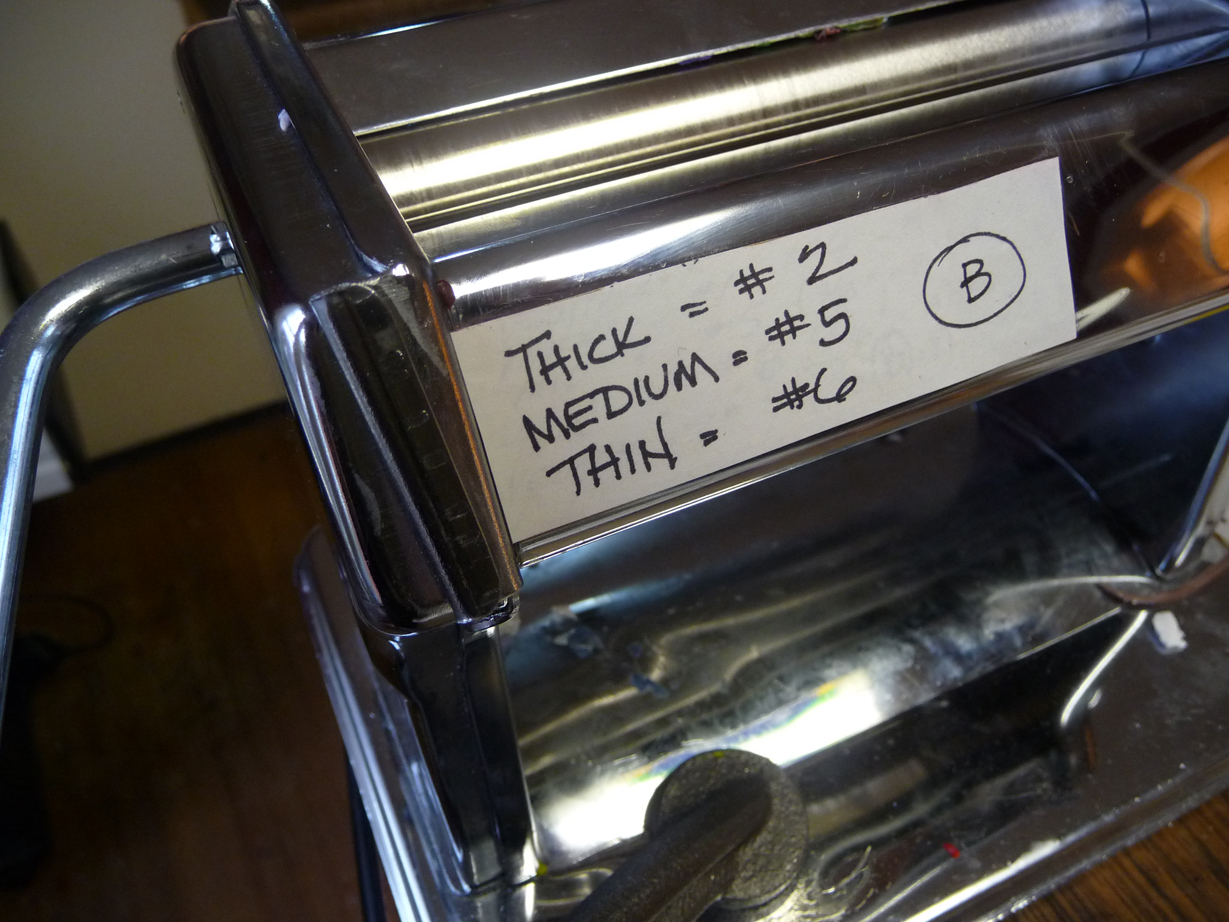
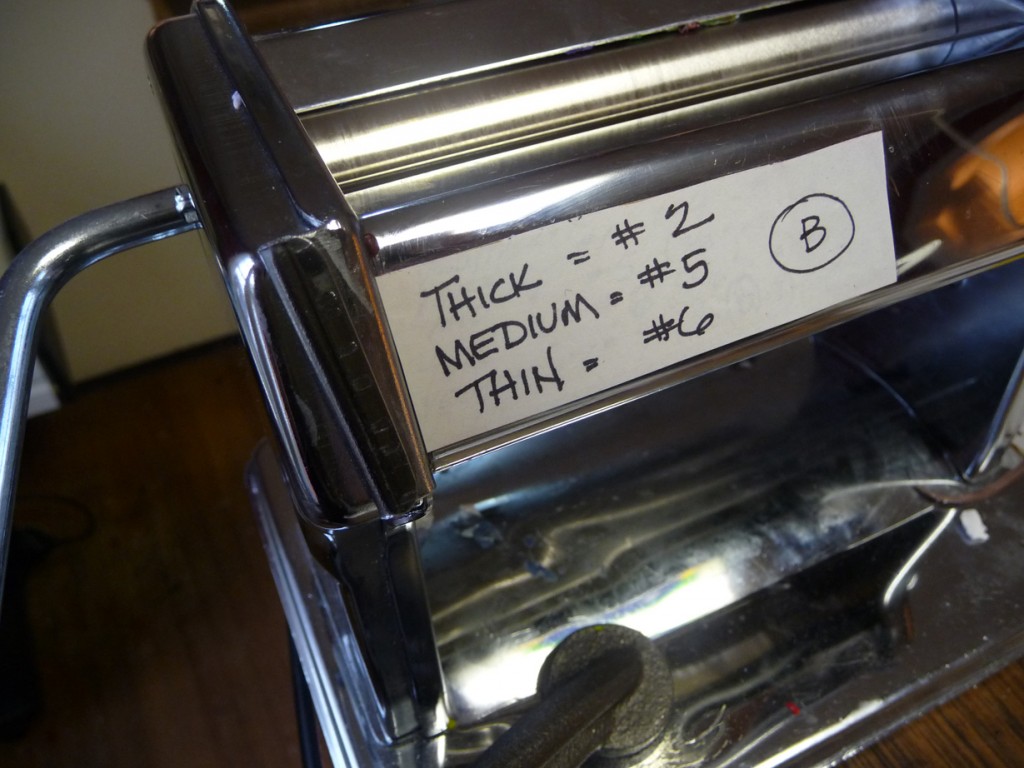
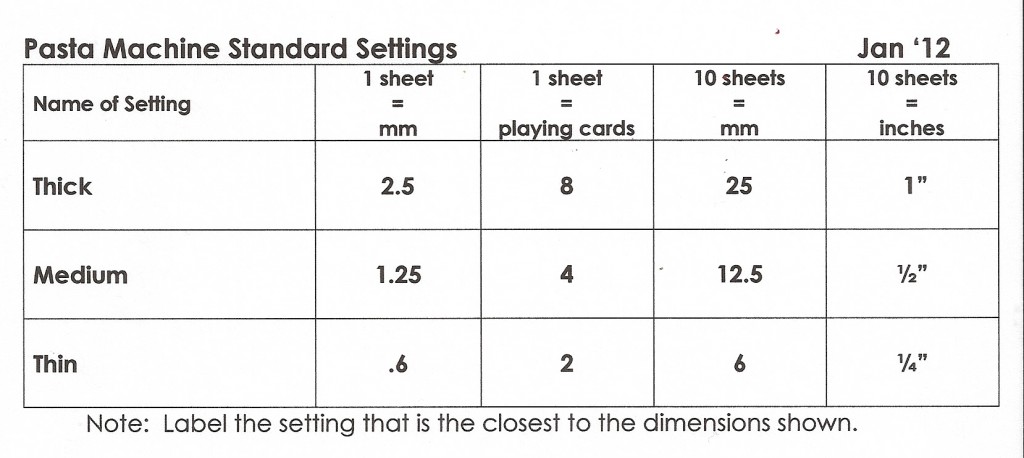
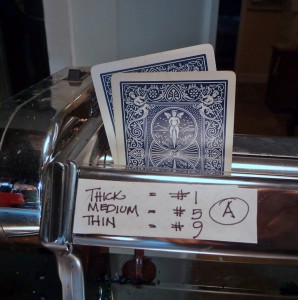

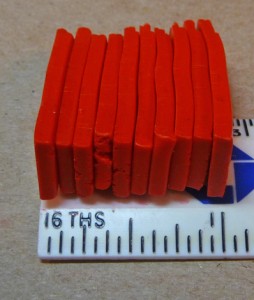
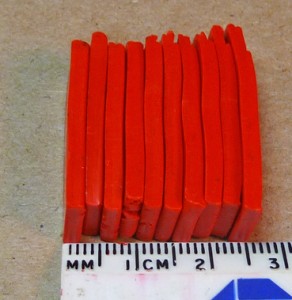

April 3, 2012 at 4:11 am
Definitely, the rest of the world is Metric. We need to be in the 21st Century!
March 24, 2012 at 3:49 am
Maggie this is an absolutely brilliant idea. I have been teaching dollhouse miniaturists to make miniature food from polymer clay since 1982 and have always struggled with the insane variability of pasta machine setting when writing instructions. I have a great Grazia machine that is my workshop workshorse but they aren’t made any more and the newer machines are often very different. This will make my life and that of my students so much easier. Thank you.
February 6, 2012 at 10:39 am
Oh boy, would this kind of standardization be incredibly helpful for beginners, and for anyone teaching a class. Even if some machines are a fraction off, this would simplify things SO much. Thanks for taking the time to figure it out, and give it some sense. I for one will be promoting using your labeling, and using it when I teach classes.
Thank you!!!
February 1, 2012 at 5:52 am
Hi Judy – Can you send me what you came up with? My lastest thinking is that we go with four basic settings for teaching purposes – Thin (1mm), Medium (1.5mm), Med. Thick (2 mm) and Thick (2.5 mm).
January 29, 2012 at 8:17 pm
Hey! Great to see the discussion is taking place. It’s the exact dilemma we faced when gathering project information for the book last spring – http://polymerclaydaily.com/2011/03/29/outer-banks-outer-limits/ – We chose to deal with it exactly how you are suggesting – Thick, medium thick, medium…. You have gone into much greater detail, but getting our community used to this type of language will be so useful! Thanks for all the hard work and experimentation.
January 21, 2012 at 4:42 am
OK it took me awhile but I did the exercise for my Atlas. It’s an eye opener to see the Altas measurements ARE different from machine to machine. Maggie can you check one number on your chart for me. You have 2 cards for thin which is .6 mm. I have 2 cards at my .9 mm setting. Probably not a big deal but my card counts are all off from yours in the thin settings but match yours in the thick.
I like the idea of a medium thick setting. That’s the area the I work in the most so adding a bit more precision in the area suits me. On the thin side I almost never venture beyond my 7 setting (out of 9) which is .9mm for me. So your thin at .6 is basically not possible with my machine. But I understand you’re taking all machines into account.
I hope my feedback helps a bit. If you want to see my thickness chart for my machine, let me know.
January 19, 2012 at 2:26 am
Thanks Cara Jane. I checked out your chart. I was surprised that the Imperia’s range is so small! It would be great to have a few settings that could be found on ALL pasta machines but .9 mm is not really thin enough to be what I would want to call THIN. I was hoping for a thickness between .6 and .7 mm.
January 17, 2012 at 12:55 pm
Hi Helen – Sage and I will be working on a proposal for Polymer Clay Daily once she gets the next issue put to bed. I am wondering about adding a mid, thick setting at just under 2 mm. There would then be 4 settings equal to 2, 4, 6, and 8 cards.
2 = thin, 4 = med, 6 = med. thick, 8 = thick. The chart could be the same but with the med.thick added. I checked for the med. thick setting on two of my pasta machines. On one its at #3 and on the other its at #4.
January 15, 2012 at 9:41 pm
I think this is an excellent idea. I have made swatches for each machine I use and measured them, but I like the idea of having everyone using the same measurement for a standard.
January 16, 2012 at 4:24 am
I missed the article about the playing cards when it came out but am happy to know that others are thinking along the same lines. I’m now in touch with Sage so we can collaborate. The cards would be a good way to do a quick check if you don’t feel like measuring and stacking up sheets of clay. I’m finding that the biggest problems are in the thick settings. I actually have an Atlas that can take 10 cards at the #1 setting – I call it my very thick setting. All have a setting that takes 8 cards so that’s why I suggested that that be called the THICK setting.
January 15, 2012 at 10:51 pm
There was an article in the winter issue of The Polymer Arts magazine on this very subject. The concept was to see how many playing cards would go through each setting on your pasta machine without forcing them and labeling the settings.
?1-2 cards: thinnest
?2 cards: thin
?3 cards: medium thin
?4 cards medium
?5 cards: medium thick
?6 cards: thick
?7-8 cards: thickest
Regardless of the method used, I agree that some sort of standard measurement should exist.
January 15, 2012 at 10:46 pm
Looks good Maggie! I’m going to do the exercise today with my machine. Looking forward to seeing the feedback on PCD. Would love this to become a globally recognized standard.
January 15, 2012 at 9:31 pm
What a great idea! I made myself a set of thickness chips and used a micrometer to measure them and made up a table comparing Imperia, Kitchen Craft and Atlas machines but I guess they will vary from machine to machine depending on how much they have been abused! If you are interested you can find it here on my blog
http://www.carajane.co.uk/2010/11/pasta-machine-thickness-comparison.html
It would be so much easier for thickness to be standardised for workshops/tutorials and your suggestion seems like a sensible and accesible way. Thanks you!
January 15, 2012 at 6:22 pm
Hi Maggie
What a brilliant idea! I’ll make sure to promote it!
Christine